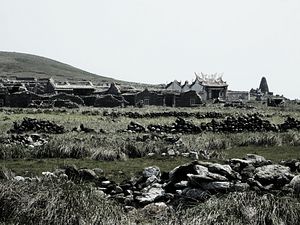The island of Xiji sits today as a wraith among the islands of Penghu County in the Taiwan Strait. Abandoned in 1978 as a result of Taiwan’s economic miracle, it is a testament to the less acknowledged effects of industrialization. For centuries, Xiji was a typical traditional Chinese community whose residents subsisted on agriculture and the bounty of the ocean. During the 1970s, as was typical with many small communities at the time, many of its youth migrated to Taiwan’s industrializing cities in search of higher wages.
What makes the case of Xiji unique is that its geography became its undoing. In the 1960s and 70s the government invested heavily in the smaller islands of Penghu. Harbors were built, dredged, and enlarged. Roadways and utility services were developed and installed. Xiji, however, could not be developed due to the dangerous submerged basalt reefs surrounding its southern coastline. Its northern half, sheer cliffs of columnar basalt pockmarked by sea caves and blow holes, was even less accessible. Deemed too expensive to develop, the island was passed over.
Therefore, in 1978 the remaining villagers of the community voted to relocate to Penghu’s main port city, Magong, and reestablish themselves as a neighborhood. Today Xiji Island is part of the recently established South Penghu Marine National Park. The island is now off-limits to visitors without a permit from the park service. The result is that a traditional Chinese village has been left in situ, uninhabited and exposed to the elements for four decades.
This year marks the 40th anniversary of the island’s abandonment. It’s an opportunity to pause and reflect on what once was, and what still remains, of Taiwan’s pre-industrial communities.
James X. Morris is studying for a PhD in Anthropology with a focus on the Asia-Pacific region at National Chengchi University in Taipei.













































